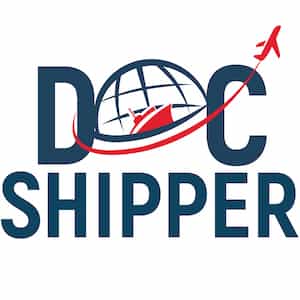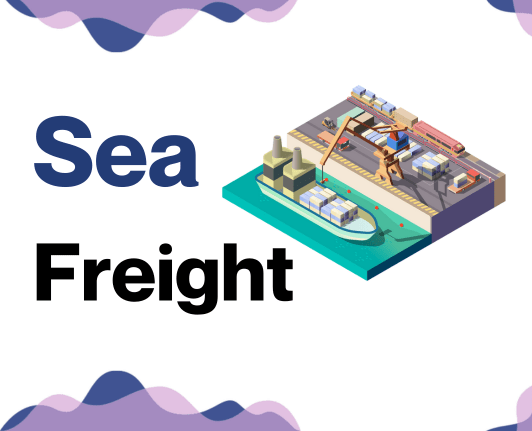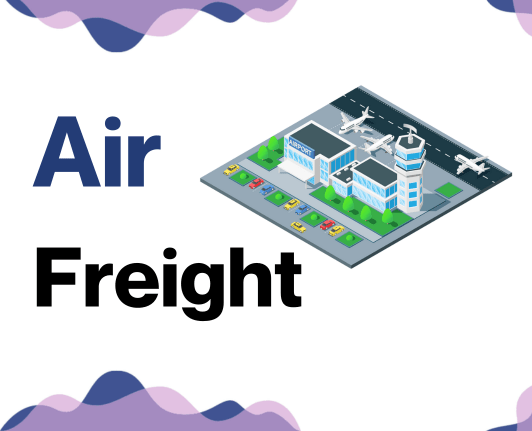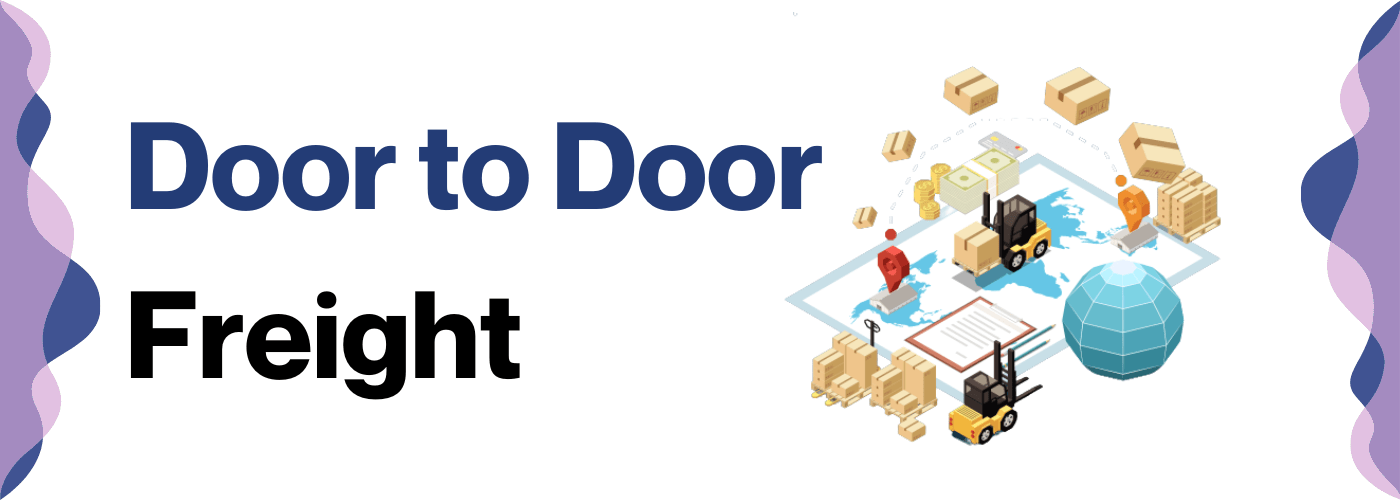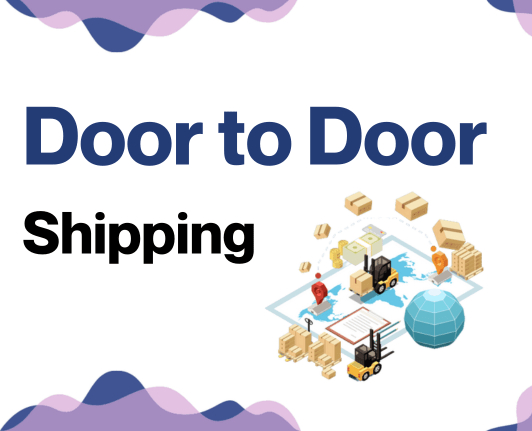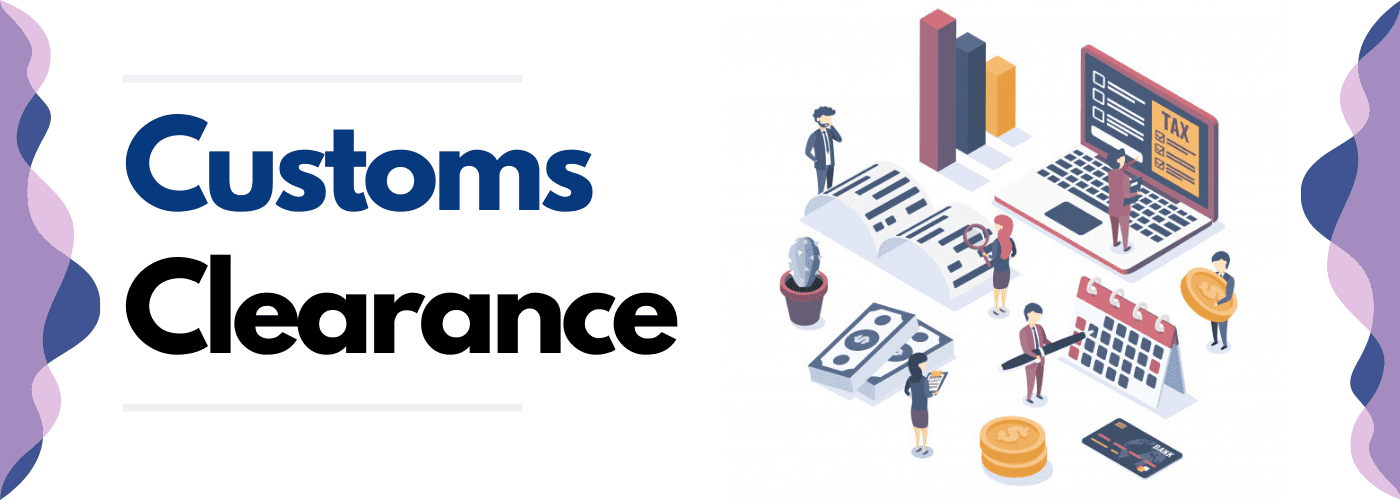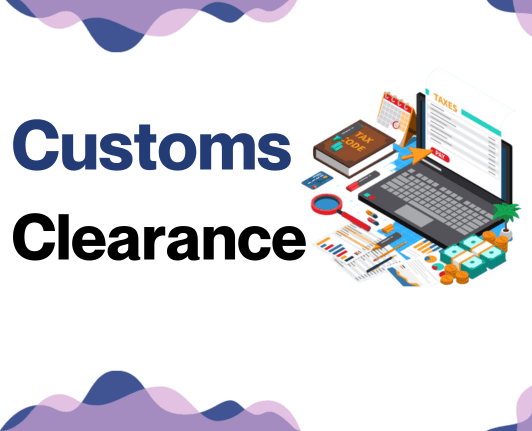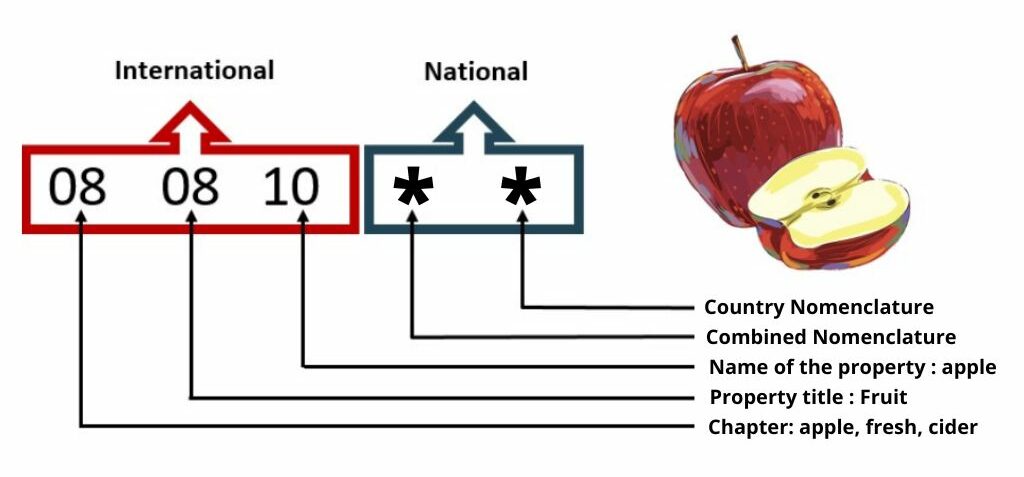Why did the shipment get a sunburn? Because it didn't have enough sea-screen! All jokes aside, grappling with the intricate maze of freight transport from Malaysia to Ireland - rates, transit times, customs rules and regulations - can feel like a Herculean task.
This guide aims to illuminate this path, providing valuable insights on freight options, whether it be by air, sea, road or rail, along with an in-depth overview of customs clearance, duties, and taxes.
We've tailored our advice to cater specifically for businesses, turning what may seem like jargon-filled red tape into manageable, actionable steps. If the process still feels overwhelming, let DocShipper handle it for you! With our world-class expertise as an international freight forwarder, we go the extra mile to change your shipping challenges into business success stories.
Table of Contents
Which are the different modes of transportation between Malaysia and Ireland?
Choosing the right mode of transport to ship goods from Malaysia to Ireland – a journey spanning 10,000 kilometers – is like plotting a cross-country road trip. Sea freight is the equivalent of a laden-down camper van – slower but cost-effective, especially for bulky items.
With fewer land obstacles, it's the most common route. Air freight is your speedy sports car - faster but costlier. It's ideal for time-sensitive goods but can be pricey. This guide aims to find your perfect transport 'vehicle', taking into account your shipment's unique nature and your company's needs.
How can DocShipper help?
Shipping goods from Malaysia to Ireland can seem daunting, but not with DocShipper by your side. We'll streamline transport, customs, and paperwork no matter the method - air, sea, road or rail. Say goodbye to complexity, say hello to simplicity. Looking for a free quote within 24 hours? Just a question away! Our consultants are ready to assist, all you need to do is get in touch!
DocShipper Tip: Sea freight might be the best solution for you if:
- You're dealing with hefty quantities or oversized goods. Sea transport is your go-to for maximizing space without stretching your budget.
- Time sensitivity isn't a concern for your shipment. Ocean freight is known for its leisurely pace, especially when compared to the speed of air or rail.
- Your supply chain connects key international harbors. This positions you to take full advantage of a wide-reaching network of ocean trade routes.
Sea freight between Malaysia and Ireland
Shipping by sea from Malaysia to Ireland is your golden ticket if you're moving large volumes of goods. Imagine a heavy-laden truck, plump with merchandise — that's the kind of bulk we're talking about. This route connects key trading posts in both countries, harnessing the bustling ports of Klang in Malaysia and Dublin in Ireland.
It's like a vital artery, pumping goods between key industrial zones. But this isn't a sprint - it's a marathon. Ocean freight might not win any speed races, but, it reaches the finish line cost-efficiently, perfect for maintaining a lean budget.
That said, anyone who's braved this maritime journey knows it's not always smooth sailing. It's like trying to solve a Rubik's Cube - puzzling over customs regulations, fumbling with documentation, all while juggling costs. Every shipper has a tale of confusion or costly mistakes made. Fear not, we've got your compass ready for this voyage.
This section deciphers those intricate knots, charting a clear course through the choppy waters of international shipping.
Main shipping ports in Malaysia
Port Klang:
Location and Volume: Located in Selangor, Port Klang is Malaysia's main maritime gateway and has a shipping volume of approximately 13.2 million TEUs. This port is the largest one in the country and the 12th busiest worldwide.
Key Trading Partners and Strategic Importance: Port Klang's primary trading partners include China, Singapore, USA, and Japan. The port's strategic placement near the Malacca Strait makes it critical for transshipments and international trade.
Context for Businesses: If you're looking to tap into markets in the Southeast Asia region or perform transshipments, Port Klang would be a consistent, reliable choice due to its capacity, strategic location, and advanced facilities.
Port of Tanjung Pelepas:
Location and Volume: Port of Tanjung Pelepas, located in Johor, has a shipping volume of about 9.1 million TEUs, making it the second busiest port in Malaysia, as well as the 18th busiest worldwide.
Key Trading Partners and Strategic Importance: China, Singapore, USA, and the Netherlands are some significant trading partners. The port is also the preferred hub by maritime freight giants, Maersk and MSC, demonstrating its strategic importance.
Context for Businesses: If your business needs are centered around high-frequency, efficient carrier connectivity, this port, with its world-renowned partners, might be your best pick.
Penang Port:
Location and Volume: Located on Penang Island, Penang Port handles over 1.5 million TEUs. It is especially known for its passenger and container vessel handling capabilities.
Key Trading Partners and Strategic Importance: Key trading partners include China, USA, Singapore, and India. Penang Port's strategic relevance lies in its role as a popular tourist entry point and its potential for handling a variety of shipments.
Context for Businesses: For businesses focusing on diversified consignments or looking for opportunities in the bustling tourist sector, Penang Port might be a great addition to your shipping strategy.
Johor Port:
Location and Volume: Positioned in the southern region of Peninsular Malaysia in Johor, Johor Port operates with an annual volume of about 1 million TEUs.
Key Trading Partners and Strategic Importance: Significant trading links include those with Indonesia, Thailand, Australia, and China. Johor Port is known for its versatile handling of general, liquid, and bulk cargo.
Context for Businesses: If your company handles a vast range of goods and seeks a multi-purpose port, Johor Port might be a valuable choice. Its broad cargo handling features exemplify its versatility.
Context for Businesses: If your company handles a vast range of goods and seeks a multi-purpose port, Johor Port might be a valuable choice. Its broad cargo handling features exemplify its versatility.
Port of Bintulu:
Location and Volume: Located in Sarawak on Borneo's island, Bintulu Port handles around 0.9 million TEUs. It's particularly recognized for handling LNG shipments.
Key Trading Partners and Strategic Importance: Main trading partners comprise Japan, Korea, Taiwan, and Australia. The port is strategically vital as it is host to ASEAN's first integrated LNG complex.
Context for Businesses: If your shipping needs are focused on the energy sector, especially the gas and petroleum industries, Bintulu Port, with its specialized LNG handling facilities, could be a key part of your shipping strategy.
Kuantan Port:
Location and Volume: Situated in Pahang on Peninsular Malaysia's east coast, Kuantan Port handles about 0.26 million TEUs annually.
Key Trading Partners and Strategic Importance: This port's primary trading partners include Vietnam, India, Indonesia, and China. Its strategic relevance is its enhanced position as an ASEAN gateway with China's Belt and Road Initiative.
Context for Businesses: If you are eyeing opportunities related to Belt and Road trade or want to connect with ASEAN partners, Kuantan Port, with its ambitious expansion plans, may be of significant strategic advantage.
Main shipping ports in Ireland
Port of Dublin:
Location and Volume: Located on the east coast of Ireland, the Port of Dublin is the largest and busiest port in the country, handling over two-thirds of all Ireland's port traffic, which equates to around 36 million tonnes of cargo annually.
Key Trading Partners and Strategic Importance: The Port of Dublin has a strategic significance, connecting Ireland with Europe, the UK, and rest of the world. Major trading partners include the UK, the Netherlands, and France.
Context for Businesses: If you're looking to tap into the market in Ireland, considering its strategic location and immense trading volume, the Port of Dublin can play a central role in your supply chain logistics.
Port of Cork:
Location and Volume: The Port of Cork is situated in the southwest region of Ireland and handles approximately 10 million tonnes of cargo traffic per year.
Key Trading Partners and Strategic Importance: It is a vital port for trade, particularly for industries such as pharmaceuticals and food. It serves trading routes to the UK, mainland Europe and the Baltic countries.
Context for Businesses: If your business is in the pharmaceutical or food industry and aims to extend your influence in Western Europe, the Port of Cork can provide efficient access to these markets.
Port of Shannon Foynes:
Location and Volume: The Port of Shannon Foynes is on the west coast of Ireland, handling a shipping volume of approximately 11 million gross tons per year.
Key Trading Partners and Strategic Importance: The port particularly facilitates trade with North America and South America, in addition to European partners.
Context for Businesses: If your business is seeking optimal connections to North American or South American markets, consider making the Port of Shannon Foynes a crucial part of your supply chain strategies.
Port of Waterford:
Location and Volume: The Port of Waterford is located in the Southeast, processing about 1 million tonnes of cargo each year.
Key Trading Partners and Strategic Importance: Its trade relationships span across the UK, Europe, and the Americas, facilitating an ample range of commodities including agribusiness and construction materials.
Context for Businesses: For businesses focusing on the agribusiness or construction sector aiming to penetrate the European and American markets, Port of Waterford can be an integral part of your operations.
Port of Rosslare:
Location and Volume: The Port of Rosslare is located in the southeast corner of Ireland, handling a limited volume of commercial traffic, which makes it less congested but highly efficient.
Key Trading Partners and Strategic Importance: The port maintains a steady trade flow with Wales and France, especially for Roll-on/Roll-off goods.
Context for Businesses: If your business operates in sectors, requiring efficient Ro-Ro logistics or if you aim to target the Welsh or French market, Port of Rosslare can serve your needs effectively.
Port of Drogheda:
Location and Volume: Located on the east coast of Ireland, the Port of Drogheda handles a shipping volume of over 1.5 million tonnes annually.
Key Trading Partners and Strategic Importance: It's particularly important for bulk cargo shipments, with major trading partners spanning across Europe.
Context for Businesses: If your business specializes in bulk maritime shipments and the primary target is European markets, incorporating the Port of Drogheda into your logistics plans could be highly beneficial.
Should I choose FCL or LCL when shipping between Malaysia and Ireland?
Embarking on sea freight shipping from Malaysia to Ireland? Pause and ponder! Your selection between Full Container Load (FCL) and Less than Container Load (LCL), or consolidation, is a game-changer. Other than affecting your wallet and shipping duration, it also plays a pivotal role in your venture's success.
This part sheds light on these two options, helps you chip away at complexities, and guides you toward an empowered decision that aligns with your unique needs. Gear up for some serious shipping enlightenment!
LCL: Less than Container Load
Definition: LCL (Less than Container Load) shipping refers to a method of transport where small, loose cargo is combined with other shippers' goods within a single container.
When to Use: LCL shipping is an ideal option when your cargo is less than 13 to 15 cubic meters (CBM). This freight forwarding service offers flexibility and affordability for low volume shipments.
Example: Consider an SME exporting handmade crafts from Malaysia to Ireland. Their weekly shipment volume is only 10 CBM. In this case, instead of leaving space unused in a full container, the company can save costs by opting for an LCL shipment, sharing the container and cost with other exporters.
Cost Implications: Pricing for LCL freight varies based on the volume and nature of commodities. It's typically higher per cubic meter than Full Container Load (FCL) shipping. However, since you only pay for the space you utilize, it's a cost-effective solution for businesses with less cargo. Note that LCL may involve additional costs for consolidation and deconsolidation services at both origin and destination ports.
FCL: Full Container Load
Definition: FCL, or Full Container Load shipping, involves renting the entire container for your shipment, whether it's a 20'ft or 40'ft container.
When to Use: If you're moving goods with a volume exceeding 13/14/15 CBM from Malaysia to Ireland, FCL should be your choice. The sealed container adds a layer of protection, securing your cargo from origin to destination.
Example: Consider a manufacturer of car parts. They need to ship a batch of engines - high value, high volume goods. FCL shipping would maintain the quality of these parts by keeping them sealed and undisturbed, reducing the risk of damage.
Cost Implications: Given the high-volume nature of your shipment, you'd find FCL more budget-friendly than LCL (Less Container Load). Though initially higher, the cost per unit can often be lower with FCL shipping – this is where obtaining an FCL shipping quote can help in understanding potential savings. Remember, it's not about just the upfront cost, but how it affects the entire supply chain budget that truly matters.
Unlock hassle-free shipping
Navigating the sea of cargo shipping between Malaysia and Ireland? Let DocShipper, our team of experienced freight forwarders take the helm. Whether consolidation or a full container is right for your business depends on budget, volume, and time-sensitivity. Our ocean freight experts will weigh these factors and chart the best course for your cargo. Start your hassle-free shipping journey now. Contact us for a free, no-obligation estimate. Sail smoothly with DocShipper.
How long does sea freight take between Malaysia and Ireland?
Sea freight typically takes between 35 to 45 days for goods to be transported from Malaysia to Ireland. Thus, it's key to remember that the exact shipping times vary according to various factors.
The selected ports, the load's weight, and the nature of the goods all contribute to the timeframe. For an accurate estimate tailored to your shipment specifics, it's suggested to get a quote from freight forwarders like DocShipper.
Regarding transit times for specific ports:
| Ports in Malaysia | Ports in Ireland | Average Transit time (in days) |
| Port of Klan | Port of Dublin | 30 |
| Port of Penang | Port of Cork | 34 |
| Port Tanjung Pelepas | Shannon Foynes | 30 |
| Port of Johor | Port of Waterford | 30 |
*These are just averages, hence, actual times may differ based on numerous parameters.
How much does it cost to ship a container between Malaysia and Ireland?
Estimating the exact cost of shipping a container from Malaysia to Ireland is as intricate as plotting a nautical chart. While ocean freight rates sway like a ship on high seas, you might be looking at a broad range for CBMs. What determines these fluctuations? It’s a concoction of variables - the voyage's start and endpoint, selected carrier, nature of your goods, and of course, the ebb and flow of monthly market rates.
But there's good news! Our shipping specialists stand ready at the helm to steer your venture, tailoring a quote that best fits your unique requirements. Let us navigate these choppy waters together and dock at the most cost-effective solution for your shipping needs.
Special transportation services
Out of Gauge (OOG) Container
Definition: An OOG container is specifically designed to accommodate cargo that exceeds standard shipping dimensions, commonly referred to as Out of Gauge cargo. These containers are open at the top or sides, allowing for flexibility in loading and unloading.
Suitable for: If your goods are excessively wide, tall or long, this option may be ideal.
Examples: Machinery parts, industrial equipment, and oversized pallets fit well into OOG containers.
Why it might be the best choice for you: OOG containers provide a secure and safe mode of transport for oversized goods, ensuring their arrival in excellent condition.
Break Bulk
Definition: This method involves the shipping of goods as individual pieces or units instead of in large containers. It's called 'break bulk' because the goods can sometimes be 'broken down' into smaller segments.
Suitable for: When you have goods that are too large for standard containers or have irregular shapes.
Examples: Wind turbines, yachts, heavy machinery parts, or steel coils are typically shipped as break bulk.
Why it might be the best choice for you: Break bulk gives you flexibility when handling, storing and transporting your goods which might not be possible with containerized transportation.
Dry Bulk
Definition: Dry bulk entails the transportation of loose cargo load like coal, grain, or minerals that are poured directly into a ship’s hold.
Suitable for: Commodities which are loose and dry, without any specific packaging.
Examples: Grain, coal, or sand can be handled with this method.
Why it might be the best choice for you: If your goods can withstand exposure to the elements and you're shipping in larger quantities, dry bulk is a cost-efficient option.
Roll-on/Roll-off (Ro-Ro)
Definition: In a ro-ro vessel, goods are driven on and off the ship on their own wheels or using a platform vehicle. They're secured within the vessel but not within containers.
Suitable for: All kinds of wheeled cargo like cars, trucks, trailers, and railroad cars.
Examples: Automobiles or construction equipment can be shipped using ro-ro vessels.
Why it might be the best choice for you: Ro-Ro is the best choice if you want to avoid extensive packing and repacking, as it reduces handling costs and the risk of damage.
Reefer Containers
Definition: These are temperature-controlled containers, maintaining a steady climate for goods that need specific conditions during transport.
Suitable for: Shipping of perishable cargo like fruits, vegetables, dairy products, and pharmaceuticals.
Examples: Seafood, meat products or organic chemicals can be shipped in reefer containers.
Why it might be the best choice for you: If you're dealing with temperature-sensitive goods, reefer containers provide a reliable solution as they prevent spoilage during transport.
In the business of sea freight shipping, understanding the shipping options is crucial. Each method has a unique advantage depending on the cargo's requirements. At DocShipper, we pride ourselves on understanding your needs and providing the best shipping solutions. If you have a shipping requirement, please reach out to us for a free shipping quote in less than 24 hours.
DocShipper Tip: Air freight might be the best solution for you if:
- You're pressed for time or facing a non-negotiable deadline. Air freight delivers unparalleled speed when it comes to transit times.
- Your shipment is modest in size, falling under 2 CBM. Air freight is particularly well-suited for these smaller consignments.
- Your supply chain includes destinations that are off the beaten maritime or rail paths. Air freight gives you access to a comprehensive global airport network.
Air freight between Malaysia and Ireland
Air freight from Malaysia to Ireland unlocks a world of speedy, reliable, and high-value logistics solutions. Picture this like assembling a Swiss-made watch - it's not bulky, but high in value, thus opting for air freight is just right. Similarly, critical pharmaceuticals that need quicker delivery also favor this mode of transport.
Choosing air freight is similar to placing a racing horse in the shipping world - swift and reliable. But just as every coin has two sides, optimizing the advantages of air freight has its pitfalls. Most shippers stumble on speed bumps like incorrect weight estimations affecting pricing, or inadvertently ignoring best practices, digging deeper holes in their pockets.
In our next section, we'll help you dodge these common mistakes and propel you on a smoother air freight journey.
Air Cargo vs Express Air Freight: How should I ship?
Thinking of transporting goods quickly between Ireland and Malaysia? It's crucial to choose the right air freight option for your business. In a nutshell, Air Cargo uses space in a commercial passenger plane, while Express Air Freight employs dedicated cargo planes. Stay tuned as we delve into the pros and cons of each, ensuring your cargo gets to its destination swiftly, cost-effectively, and hassle-free.
Should I choose Air Cargo between Malaysia and Ireland?
Opting for air cargo between Malaysia and Ireland could be a cost-effective and reliable choice for your business, particularly if your freight exceeds 220/330 lbs (100/150 kg). Airlines like Malaysia Airlines and Aer Lingus, offer freight services known for their reliability. Keep in mind though, that fixed schedules might result in longer transit times.
However, judging from a budget perspective, this option becomes very attractive, enabling you to balance your finances while ensuring your goods are delivered in one piece. Choosing this freight method aligns reliability with cost-effectiveness, a winning combination for your business shipping needs.
Should I choose Express Air Freight between Malaysia and Ireland?
Express air freight, a service offered by industry giants such as FedEx, UPS, and DHL, utilizes specialized cargo planes devoid of passengers to move your goods. If your shipment to Ireland from Malaysia is under 1 CBM or weighs between 100 and 150kg, this speedy and secure mode of transportation could be ideal.
The nimble handling of smaller, urgent cargoes is a key benefit, ensuring your business continuity is never disrupted. Bear in mind this service tends to be pricier than others, yet it promises timely delivery, perfect for meeting tight deadlines or if speed is paramount. The choice lies in balancing your needs and budgets.
Main international airports in Malaysia
Kuala Lumpur International Airport
Cargo Volume: KLIA handles nearly a million tons of cargo a year.
Key Trading Partners: The majority of trade through KLIA is attributed to China, India, Indonesia, Japan, and Singapore.
Strategic Importance: KLIA is not only the busiest airport in Malaysia but also a vital regional aviation hub located in a strategic position in Southeast Asia.
Notable Features: This airport houses the Advanced Cargo Centre, a state-of-the-art cargo terminal that offers comprehensive logistic solutions.
For Your Business: KLIA’s central location in the ASEAN region, and its advanced cargo handling facilities may provide cost-effective and efficient solutions for your shipping needs.
Penang International Airport
Cargo Volume: The airport processes just under 200,000 tons of cargo annually.
Key Trading Partners: Major trading partners include China, Singapore, Indonesia, Vietnam, and Thailand.
Strategic Importance: As the third busiest airport in Malaysia, Penang International Airport is a significant gateway to Northern Malaysia with expanding routes to Southeast Asia.
Notable Features: The airport is planning a massive expansion to increase its cargo handling capacity, quadrupling its size by 2027.
For Your Business: Its growing cargo handling capacities and strategic location are beneficial for businesses targeting Northern Malaysia and broader regional markets.
Sultan Abdul Aziz Shah Airport
Cargo Volume: The airport handles around 100,000 tons of cargo in a year span.
Key Trading Partners: Trade predominantly occurs with countries in Southeast Asia like Thailand, Singapore, and Indonesia.
Strategic Importance: Located in the nation's capital, this airport benefits from being at the heart of Malaysia's busiest city and administrative center, Kuala Lumpur.
Notable Features: It is favored for its smaller size and less congested space than KLIA, making cargo processes potentially smoother and quicker.
For Your Business: If you're prioritizing speed and efficiency in the delivery process, this airport’s smaller scale and strategic location could be worthwhile.
Bintulu Airport
Cargo Volume: Approximately 50,000 metric tons of cargo are processed through this airport in a year.
Key Trading Partners: Most trade here is with domestic and few Southeast Asian locations, primarily Indonesia.
Strategic Importance: Located in Bintulu, an industrial city, this airport is vital for the transportation of locally produced goods, like LNG.
Notable Features: The airport is well-equipped to handle heavy cargo, primarily in industrial machinery and similar freight.
For Your Business: For businesses involved in heavy industry or requiring the shipment of large machinery, Bintulu Airport’s cargo facilities might be the perfect fit.
Miri Airport
Cargo Volume: Lately, this airport processed around 20,000 metric tons of cargo a year on average.
Key Trading Partners: Majority of trade takes place with Southeast Asian countries like Brunei, Indonesia, and domestically within Malaysia itself.
Strategic Importance: As the second busiest airport in Malaysia, it serves as a vital domestic hub with potential for regional reach.
Notable Features: This airport is a popular choice for businesses looking for strong domestic connections within Malaysia.
For Your Business: If shipping within Malaysia is a major part of your company's operations, Miri Airport's high domestic connectivity could be advantageous for you.
Main international airports in Ireland
Dublin Airport
Cargo Volume: Dublin Airport processes over 35% of Ireland's air cargo, totaling to nearly 139,000 tonnes annually.
Key Trading Partners: Major trading markets include the UK, USA, Germany, and China.
Strategic Importance: Acting as Ireland's premier international gateway, it plays a vital role in facilitating Ireland-EU trade and beyond.
Notable Features: Dublin Airport is equipped with a modern cargo terminal and world-class infrastructure making it a reliable choice for handling perishable goods and time-sensitive shipments.
For Your Business: If your company largely trades with the markets mentioned and requires a dependable logistics hub, Dublin Airport is a prominent option.
Shannon Airport
Cargo Volume: Handles over 13,000 tonnes of cargo annually and continues to grow.
Key Trading Partners: United States, China, United Kingdom.
Strategic Importance: The airport is the first European landing point for flights from the Americas. Its unique location provides businesses a competitive edge, especially for those engaged in transatlantic trade.
Notable Features: Known for its large runway and US Preclearance facilities.
For Your Business: If you frequently meet deadlines for goods to and from the United States, Shannon Airport(https://www.shannonairport.ie/) can serve as an efficient logistics partner.
Cork Airport
Cargo Volume: Processes approximately 2,500 tonnes of cargo annually, but significantly supports Ireland's southern region.
Key Trading Partners: Primarily European countries, with the UK and France topping the list.
Strategic Importance: Despite handling lesser cargo volume, Cork Airport is crucial for businesses situated in the southern region of the country, especially those involved in seafood exports.
Notable Features: Houses the National Marine College of Ireland, augmenting its importance in seafood exports.
For Your Business: For businesses specially focused on seafood exports within the European region, Cork Airport(https://www.corkairport.com/) may be an optimal choice.
Kerry Airport
Cargo Volume: While figures are unavailable due to its smaller size, the airport mainly serves the southwestern part of the nation.
Key Trading Partners: Majorly the UK, with the potential for expanding routes to other EU countries.
Strategic Importance: Provides crucial connectivity for businesses based in Southwest Ireland, ensuring the area remains competitive.
Notable Features: It is ideal for businesses dealing with less volume, offering efficient handling and shorter waiting times.
For Your Business: If your business operations are located in Southwest Ireland, Kerry Airport(https://www.kerryairport.ie/) could offer swift and easy connection to the UK and potential for other EU links.
Knock - Ireland West Airport
Cargo Volume: Processes an undetermined but small volume of cargo, primarily serving Mayo and the West of Ireland.
Key Trading Partners: Primarily serves the UK, but is expanding its market reach.
Strategic Importance: Serves the western region ensuring connectivity for businesses located here.
Notable Features: It could be a strategic choice for businesses dealing in perishable goods or looking for a less crowded airport.
For Your Business: If your business frequently ships goods to or from the UK and is located in the western region, Knock - Ireland West Airport might suit your needs effectively.
How long does air freight take between Malaysia and Ireland?
Shipping goods by air freight between Malaysia and Ireland usually takes approximately 6-8 days. However, keep in mind that transit times can vary. Factors such as the specific airports of origin and destination, the weight and volume of your cargo, and the nature of the goods being shipped all play into the overall timeline.
For an accurate measurement of transit time tailored to your specific needs, it's best to consult directly with a reputable freight forwarder, like DocShipper.
How much does it cost to ship a parcel between Malaysia and Ireland with air freight?
Shipping air freight between Malaysia and Ireland can cost somewhere between $4 to $7 per kg. However, it's challenging to quote an exact price due to factors such as distance from departure and arrival airports, weight and dimensions of the shipment, and nature of goods.
But don't worry, our team is dedicated to offering the best possible rates, customizing every quote to each unique circumstance. Reach out now to receive your free quote within 24 hours.
What is the difference between volumetric and gross weight?
Gross weight is the total weight of your shipment, including all packaging materials, like boxes and pallets. Volumetric weight, on the other hand, is a weight estimate that considers the size of your package rather than the actual weight.
In air cargo shipping, gross weight is pretty straightforward - you simply weigh your fully packed item on a scale. For volumetric weight, you'll need to calculate it. The formula is (Length(cm) x Width(cm) x Height(cm)) / 6000, which gives you the volumetric weight in kg.
Let's consider a hypothetical shipment where your packed box is 50cm x 50cm x 50cm and weighs 25kg. Your volumetric weight would be: (50 x 50 x 50) / 6000 = 20.83kg (or 45.94 lbs). Despite your gross weight being 25kg (or 55.12 lbs), your volumetric weight is less.
In Express Air Freight services, the only change is the divisor in the formula, which becomes /5000, resulting in a higher volumetric weight in comparison. Using the same hypothetical package and formula, you would get (50 x 50 x 50) / 5000 = 25kg (or 55.12 lbs).
This distinction is important because in air freight shipping, you are billed based on whichever is higher - the gross or the volumetric weight. So, understanding how each is calculated can help you control your shipping costs and better plan your packaging and shipping strategies.
DocShipper tip: Door to Door might be the best solution for you if:
- You value convenience and want a seamless shipping process, as door-to-door takes care of every step from pickup to delivery.
- You prefer a single point of contact, as door-to-door services typically provide a dedicated agent to handle all aspects of the shipment.
- You want to minimize the handling of your goods, reducing the risk of damage or loss, as door-to-door minimizes transitions between different modes of transport.
Door to door between Malaysia and Ireland
Cracking the jargon, 'Door to Door' shipping is an all-inclusive service that ships your goods from their origin in Malaysia straight to their destination in Ireland. Streamlined, efficient, and often cost-effective, it reduces the headache of dealing with multiple logistics providers. Sounds ideal for stress-free shipping, right? Now, let's dive into the nitty-gritty of it!
Overview – Door to Door
Looking for seamless shipping from Malaysia to Ireland? Our Door-to-Door service streamlines logistics, conquering all complexities. It's a one-stop solution that handles everything: transport organization, customs clearance, and administrative procedures.
Despite being slightly costlier, it's a superior choice, offering you peace of mind and a shipment at your doorstep. This all-inclusive service is a top pick among our DocShipper clients! Thanks to Door-to-Door, let shipping be the least of your business hassles. Here's to stress-free international logistics!
Why should I use a Door to Door service between Malaysia and Ireland?
Ever dreamt of instant teleportation for your goods from Malaysia to Ireland? Well, we haven't figured out that space-time mystery just yet, but Door-to-Door services are the next best thing! Here's why:
- Stress-free Logistics: Who's got time to sweat the logistics? You're busy running a business! We arrange for pickup and safe transportation of your goods from your doorstep to the final destination, no fuss whatsoever.
- Speedy Gomez of Deliveries: Like Speedy Gonzalez, but for your shipments! If urgency is your watchword, Door-to-Door services could be your superhero. We make sure your goods follow the quickest possible route for a timely and efficient delivery.
- Specialized Care for Complex Cargo: Juggling live lobsters or transporting priceless statues? Complex cargo deserves special attention. That's why our Door-to-Door services provide tailored solutions to take utmost care of your exclusive freight needs.
- Convenience on the House: Literally, as we handle all the trucking until it reaches the house, warehouse or office! With one company orchestrating the entire journey, you save time and enjoy the convenience only a seamless service can provide.
- Every Step Monitored: From bubbling brooks in Borneo to the rocky coasts of Cork, we’re with your goods every step of the way! You’ll have end-to-end visibility through our tracking system.
So, say goodbye to shipping nightmares and hello to the A-team of logistics - the stress-busting, speedy and superior Door-to-Door service. We promise, this isn't an 'over-the-sea-and-far-away' pipe dream!
DocShipper – Door to Door specialist between Malaysia and Ireland
Experience stress-free, door-to-door shipping from Malaysia to Ireland with DocShipper. We handle the entire process, from packing to customs clearance, utilizing every shipping method to ensure efficient delivery.
Our well-versed team provides you with a dedicated Account Executive to ensure a smooth process.
Reach out for a free estimate within 24 hours or get in touch with our consultants for complimentary advice. Your shipping needs, met with utmost professionalism. That’s DocShipper's promise to you.
Reach out for a free estimate within 24 hours or get in touch with our consultants for complimentary advice. Your shipping needs, met with utmost professionalism. That’s DocShipper's promise to you.
Customs clearance in Ireland for goods imported from Malaysia
Navigating the labyrinth of customs clearance when importing goods from Malaysia to Ireland can be a complex chore. Missteps can result in unexpected fees, charges, or even your goods getting snagged in customs!
To steer clear of these obstacles, it's crucial to understand the ins and outs of customs duties, taxes, quotas, and licenses.
Don't worry, we'll break down all the important details in the following sections to ensure a smooth journey for your goods. Remember, our team at DocShipper is just a call away. We can assist throughout the entire process for any type of goods and any location worldwide. Just shoot us your goods’ origin, value, and HS Code and we'll provide you with a tailored budget estimate.
How to calculate duties & taxes when importing from Malaysia to Ireland?
Understanding the estimation of duties and taxes when importing goods from Malaysia to Ireland can seem perplexing at first, but with the right knowledge it becomes a structured process to follow.
At the heart of calculating customs duties, it's essential to consider factors like the country of origin - where the goods were manufactured or produced, the Harmonised System or HS code that classifies products, the Customs Value which is the total cost of the goods being shipped, the Applicable Tariff Rate - which can vary depending on the product category and trade agreements, and potential other taxes and additional fees specific to the goods in question.
The first step in this journey of calculation is identifying the country where the goods were manufactured or produced. This is crucial because it can influence tariff rates and other components of the overall duty cost. So before going any further, start by confirming the exact origin of your shipment. It could be the first step to smoother and more cost-effective shipping operations across the globe.
Step 1 - Identify the Country of Origin
Knowing the Country of Origin - Malaysia in your case, holds immense weight in international shipping. First off, it’s the keystroke to figuring out your commodity's Harmonized System (HS) code, the universal language for classifying goods. Secondly, customs authorities pay close attention to the origin country when assessing duties and taxes.
Now, let's leap into the trade agreements. Malaysia and Ireland, they have quite a synergy! For certain goods, you can leverage their bilateral agreements to enjoy lower or zero customs duties. However, remember the devil's in the details. Get a professional assessment to confirm if your goods fit the bill.
Stumbled upon any import restrictions? Don't fret! Malaysia to Ireland shipment isn't necessarily a stone's throw, but with correct documentation and compliance with Irish regulations - it's manageable. Partner with a knowledgeable freight forwarder to navigate these waters.
Here's a bonus tip: Take Charge! Learning the ins and outs of this process adds to your business resilience. You'll be in the driver's seat, ruling every stage of your shipment's journey. Remember, knowledge is power, especially when you're importing goods cross-border.
Step 2 - Find the HS Code of your product
A Harmonized System (HS) Code is a standardized numerical method of classifying traded products. Developed by the World Customs Organization, it's used by customs authorities around the world to identify products when assessing duties and taxes and for gathering statistics.
You might be wondering, How do I find the HS Code of the product I wish to export or import? Often, the simplest way to discover this code is by consulting your supplier directly. Since they are usually familiar with what they're importing and the related regulations, they can readily provide you with this crucial information.
However, if that's not an option, don't worry, we've got you covered. By following these simple steps, you can find it out easily:
1. Visit the Harmonized Tariff Schedule.
2. Enter the name of your product in the search bar.
3. Review the results and check the Heading/Subheading column - that's where you'll find your product's HS Code.
It's worth emphasizing that accuracy in identifying and using the correct HS Code is crucial. Inaccuracy could result in delays in goods clearance, extra costs, or even potential fines. Therefore, exercising due diligence is essential for a seamless shipping process.
We've also put together a handy infographic to guide you on how to read an HS code, ensuring you're armed with all the necessary information for your shipping needs.
Step 3 - Calculate the Customs Value
Think of customs value as the total worth of your goods once they've arrived at Ireland's door from Malaysia - it's often not the same as the product's price alone. While the true price of your merchandise is surely important, customs considers more than this. They evaluate the CIF value - this is the Cost, Insurance, and Freight collectively.
To paint a clearer picture: if you purchase items totalling $1,000, pay $200 for shipping, and invest $50 in insurance, your CIF, or customs value, is $1,250. It's the total of these three elements that customs will use to determine any fees.
Recognizing the difference between product value and customs value can save you from any unexpected costs and hassle. Keep an eye on the CIF value to properly anticipate the customs process in Ireland.
Step 4 - Figure out the applicable Import Tariff
Import tariffs are a form of tax imposed on goods imported into a country. In Ireland, which is part of the European Union, these tariffs are determined by the Common Customs Tariff (CCT).
To determine the tariff for your specific product, you can use the TARIC System - European Customs. Entering the HS (Harmonized System) code of your product and specifying Malaysia as the country of origin will provide you with the exact duties and taxes to be paid.
For instance, let's say you're importing footwear classified under HS code 6403 from Malaysia. You enter this code and Malaysia into the TARIC System. Assuming the tool displays a Common External Tariff (CET) of 12%, you can then calculate the import duties.
For instance, if your insurance and freight costs (CIF) are USD 10,000, your import duties would be 12% of that, or USD 1,200. This makes understanding and calculating import tariffs critical for accurate financial planning for your business.
Step 5 - Consider other Import Duties and Taxes
In addition to the standard tariff rate, you may encounter other import duties when importing goods from Malaysia to Ireland. The nature of your product and its country of origin can influence these.
For instance, excise duty applies to certain goods like tobacco or alcohol. Anti-dumping taxes help protect domestic industry from foreign goods sold under market value. Now, for the all-important VAT.
It's calculated based on the combined cost of the goods, transportation, and any import duties. So, If your invoice states $200 for goods, $50 for shipping, and you have an import duty of $20, the VAT will apply to the total sum, which in this case is $270.
Bear in mind, these are just hypothetical figures and the actual rates can vary.
Understanding these aspects can help you avoid any unexpected expenses and allow for more accurate budgeting. Familiarizing yourself with your product type and the corresponding tax rules can streamline your shipping process, making it both efficient and cost-effective.
Step 6 - Calculate the Customs Duties
Calculating customs duties can be a complex task, involving several components such as customs value, Value Added Tax(VAT), anti-dumping taxes, and Excise Duty. Begin by finding the customs value of your goods. This is the cost of your goods converted into USD, plus transport and insurance charges to the EU border.
- First, if only customs duties apply, the calculation is pretty straightforward: Customs Value x Customs Duty Rate. For example, if your goods' value is USD 10,000 and the Duty Rate is 10%, you will pay USD 1,000 in Customs Duties.
- Second, if customs duties and VAT apply, both must be calculated. Let's say the customs duties come to USD 100 and the VAT is 23%(Ireland VAT rate). Your VAT is then calculated as (Customs Value + Customs Duty) x VAT. So VAT becomes (10,000 + 100) x 23% = USD 2,323.
- Lastly, if you have customs duties, VAT, and anti-dumping taxes, add another component to the costs. Let’s assume an anti-dumping tax of 5% on a USD 10,000 shipment. The calculations become (Customs Value + Customs Duty) x VAT + Anti-Dumping Tax, which would equate to (10,000 + 100) x 23% + 500 = USD 2823 + Excise Duty.
Keep in mind Excise Duty will apply to specific goods like alcohol or tobacco.
While these calculations give you an idea of how duties are assessed, actual procedures can be intricate. DocShipper can help simplify this. We handle every step of customs clearance worldwide, ensuring that you don't overpay. Contact us for a free quote within 24 hours.
Does DocShipper charge customs fees?
DocShipper, as your dedicated customs broker in Malaysia and Ireland, ensures transparency in all communications concerning costs. We handle customs clearance fees, but any customs duties or taxes go directly to the government.
This means you only pay for what's determined by customs officials and you receive all related documents as proof. So, if you've recently shipped a batch of machinery from Ireland to Malaysia and find yourself puzzled about the financials, remember – the customs office sets the taxes, we simply facilitate the process.
Contact Details for Customs Authorities
Malaysia Customs
Official name: Royal Malaysian
Customs Department
Official website:
Required documents for customs clearance
Shipping goods globally can feel like a maze of paperwork. Unclear about what documents you need for customs clearance? We’re here to help. From explaining the Bill of Lading to the Certificate of Origin, we'll shine a light on this seemingly complex process. Let's streamline your shipment together!
Bill of Lading
Navigating the sea or skyways from Malaysia to Ireland? You can't navigate without your compass - the Bill of Lading. Think of the Bill of Lading as your handover certificate - it's an absolute must-have to mark the transition of ownership.
It’s the contractual agreement between you and your freight carrier, important for resolving any disputes about what was shipped and what was received. Want to speed things up? Consider the electronic or 'telex' release of the Bill of Lading.
It transfers your ownership online, making your shipping life a lot less paper-centric. Don't forget, if you're favouring air over sea, substitute the Bill of Lading with the Air Waybill (AWB). Both documents serve the same purpose but remember, they’re designed for their respective transportation methods.
So when it comes to either shipping scenario, keep them at the top of your checklist and let your goods set sail...or take flight.
Packing List
When preparing your freight from Malaysia to Ireland, one underpinning document is the Packing List. Think of it as the DNA of your shipment, stating what, how many, and how it's packed. Imagine you're shipping 50 crates of electronic devices - your Packing List should detail the contents of each crate.
It's your responsibility to ensure its accuracy. Why? Because Customs uses it to verify your shipment against duties and taxes. Equally relevant for sea and air freight, an inaccurate Packing List could lead to delays or fines. So whether it's 100 pieces of garments or just one high-value machinery part, don't underestimate the power of the Packing List!
Commercial Invoice
Shipping goods from Malaysia to Ireland? Your Commercial Invoice is an essential document for customs clearance. It provides detailed information about your shipment, including the price, quantity, and nature of goods, crucial for customs duties calculation.
For smooth clearance, thoroughly cross-verify your invoice with other shipping documents for consistency. Maybe you're shipping electronics.
Make sure the product descriptions on your invoice and Bill of Lading match - 'Mobile Phones' in one shouldn't be 'Electronic Devices' in another. Also, remember to list prices in a currency recognized by both countries, like USD or EUR, to avoid any hiccups. This could save your business from unnecessary delays and costs.
Certificate of Origin
Starting with the essential paperwork, let's dive into the Certificate of Origin. Think of it as a passport for your goods. It validates the ‘nationality’ of your cargo, which in this case, should be Malaysia or Ireland. Accurately specifying your goods' manufacturing country can make a big impact by sometimes granting you preferential customs duty rates under pre-established trade agreements between these two nations.
For example, you're shipping electronics made in Malaysia to Ireland. With the correct Certificate of Origin, you can enjoy lower duty rates, thus saving money that can be reinvested into your business. So, ensure to correctly mention the country of manufacture for the smooth, cost-effective transportation journey.
Certificate of Conformity (CE standard)
The Certificate of Conformity authenticates your goods' compliance with European Union's CE standards, a crucial step when shipping from Malaysia to Ireland. Unlike normal quality assurance — a manufacturer centric label, the CE Marking ascertains your product's compliance with EU directives.
It's a legal requirement signifying safe-to-use goods within the European Economic Area. Contrastingly, the US relies on certifications like the FCC and UL. But don't be overwhelmed! Start by assessing if your goods need this certification — not all do. Then, detail your product's specific requirements before seeking a Notified Body's help for evaluation.
Remember, it's your ticket in, showing customers your commitment to safety and quality. Demystifying these requirements turns them from potential obstacles to your successful market entry. Note that the UK now uses the UKCA marking post-Brexit. Be sure to check these details for every specific EU market you aim for.
Your EORI number (Economic Operator Registration Identification)
Picture this: You're shipping a batch of electronics from Kuala Lumpur to Dublin and can't understand why your shipment is delayed at customs. It could be due to the lack of an EORI Number – a key component in EU's import-export framework.
The EORI Number is your passport in the business world of EU trade, acting as a unique identifier for your business throughout customs procedures in the EU, including Ireland. Getting your EORI Number is like getting your ID card; it’s mandatory, straightforward, and can be done online through the local tax authority's website.
Don't underestimate this alphanumeric buddy; it’s the gatekeeper for your goods, boosting their smooth journey across the EU.
Get Started with DocShipper
Navigating customs clearance between Malaysia and Ireland can be complex. At DocShipper, we simplify this process with our expertise in international shipping regulations and paperwork. Let us handle every step, ensuring a seamless journey for your goods. Interested? Contact us for a free quote. Expect a reply within 24 hours to start easing your shipping hassles today.
Prohibited and Restricted items when importing into Ireland
Moving goods into Ireland isn't always smooth sailing. You might encounter difficulties with certain goods that Ireland deems prohibited or restricted. Let's dive into these regulations to ensure your shipments arrive without any hiccups or delays.
Restricted Products
- Drugs and Medicines: You'll need to contact the Health Products Regulatory Authority to get a permit for these items.
- Firearms and Ammunition: Before you can send firearms or ammunition, you must get a permit from the Garda Síochána (Police).
- Animals and Plants: Thinking of shipping any live animals, plants, and their by-products? You'll have to apply to the Department of Agriculture, Food and the Marine.
- Hazardous Chemicals: If your shipment includes dangerous or hazardous chemicals, a license from the Health and Safety Authority is mandatory.
- Food items: If you're considering shipping food items, a permit from the Food Safety Authority of Ireland is required.
- Alcoholic Beverages: To export/import alcoholic beverages, you must contact the Revenue Commissioners.
- Tobacco Products: Planning to ship tobacco products? A license from the Revenue Commissioner is essential.
- Cultural goods and works of art: If these are part of your shipment, check in with the Department of Tourism, Culture, Arts, Gaeltacht, Sport and Media.
Prohibited products
- Narcotics and illegal drugs: These include marijuana, cocaine, heroin, and many other drugs.
- Offensive weapons: Items such as switchblade knives, firearms, explosives, and other objects that can cause harm are not allowed.
- Indecent and obscene material: This includes child pornography and other materials deemed offensive.
- Counterfeit and pirated goods: Products that infringe on copyrights or trade trademarks, including pirated films, music, and fake designer clothes.
- Endangered Species: Items made from endangered species such as ivory, tortoiseshell, certain furs, etc.
- Hazardous materials: Certain chemicals and substances that are dangerous to human health or the environment.
- Certain plant and animal products: Some plant and animal products are not allowed entry to prevent the spread of diseases and protect ecosystem health.
- Rough Diamonds: Importing rough or uncut diamonds into Ireland is prohibited under the Kimberley Process.
- Radioactive substances and irradiating apparatus.
- Unwrought precious metals and stones: Loose, unworked precious metals and stones, like diamonds and gold in their natural form, cannot be imported to Ireland without special permission.
Are there any trade agreements between Malaysia and Ireland
Currently, there are no formal Free Trade Agreements (FTAs) or Economic Partnership Agreements (EPAs) between Malaysia and Ireland. However, the European Union (EU), of which Ireland is a member, is engaged in negotiations with Malaysia towards a potential FTA.
This could streamline your business shipping in the future by reducing tariffs and simplifying customs procedures. Plus, broader initiatives, like the ASEAN-EU Comprehensive Air Transport Agreement, hint at improving transport links that could benefit your operations. Always stay updated with these developments for a competitive edge.
Malaysia - Ireland trade and economic relationship
The economic ties between Malaysia and Ireland have grown robustly since the 1970s. Highlighted by milestones such as the establishment of the Malaysia-Ireland Economic and Trade Committee (MIETC) in 2010, both nations have enriched trade in key sectors including electronics, medical devices, and financial services.
Major commodities such as electrical machinery and optical instruments dominate the trade basket. Ireland is Malaysia’s 9th largest EU partner, with total bilateral trade exceeding $2.5 billion annually. More than 50 Irish companies have established operations in Malaysia, with notable investments in high-value sectors like IT services and biotechnology.
Your Next Step with DocShipper
Exhausted from tangles of paperwork and puzzles of customs? Let DocShipper eliminate your shipping woes from Malaysia to Ireland. Our team will handle door-to-door cargo services, customs clearance, and all the nitty-gritty details. Concentrate on progress while we manage your shipment's journey. Fancy a helping hand? Contact us now, and let's move your business forward.
Additional logistics services
Explore beyond shipping and customs with our robust suite of additional logistics services. From packaging to warehousing, DocShipper covers your entire supply chain needs for a seamless trading experience. Let us simplify the logistics labyrinth for you.
Warehousing and storage
Keeping your goods safe across Malaysia-Ireland routes can be tricky. You need reliable warehouses that can meet specific needs like temperature control for perishables. Don’t let your valuable shipments suffer; have a look at our Warehousing services for tailor-made solutions. From chilled rooms for fresh fruits to secure holds for electronics, we've got you covered. More info on our dedicated page: Warehousing.
Packaging and repackaging
Attention to packaging is crucial when shipping from Malaysia to Ireland, ensuring your goods arrive safely and undamaged. Working with a competent partner like us can make a world of difference. Think electronics, delicate crystalware, or bulky machinery. We handle each with expert care, wrapping, and repackaging when necessary. Learn more about our detailed shipping safeguards on our dedicated page: Freight packaging.
Cargo insurance
Transporting cargo and potential hazards are bedfellows. Cargo insurance, unlike fire insurance, swoops in as a saviour, safeguarding your goods during their whole journey, not just when the flame flickers. In storm-drenched seas or bumpy air routes, this essential service minimises your risk. Picture fragile arts heading to a Dublin gallery; insurance means no Irish tears over broken masterpieces. More info on our dedicated page: Cargo Insurance
Supplier Management (Sourcing)
Looking to manufacture in Asia or East Europe but unsure about the sourcing? DocShipper eases your process by shortlisting ideal suppliers and managing the procurement. We help you overcome language gaps while guiding you from start to finish. Think of us as your compass in the world of global sourcing! More info on our dedicated page: Sourcing services
Personal effects shipping
Moving personal items from Malaysia to Ireland? Expect convenience and absolute care, especially with fragile or bulky belongings. Our professionals utilize flexibility to adapt to your specific needs. Just like how Mrs. O'Shea smoothly shipped her antique Malaysian furniture back to Dublin! Seek more info on our dedicated page: Shipping Personal Belongings.
Quality Control
Quality control is your secret weapon when shipping merchandise from Malaysia to Ireland. It ensures that production or customization errors don't make their way into your shipments, saving on the costs and hassles of returns and adjustments. Imagine detecting flaws in your textiles or electronic components before they hit the Irish market. Prevention is easier and cheaper than the cure! More info on our dedicated page: Quality Inspection
Product compliance services
Forget about the legal headaches! When shipping products, compliance to destination regulations is vital. Our Product Compliance Services offer peace of mind with rigorous lab testing and certification, ensuring your items comply every time. Picture a smooth shipping experience with no customs hiccups. More info on our dedicated page: Product Compliance Services.
FAQ | For 1st-time importers between Malaysia and Ireland
What is the necessary paperwork during shipping between Malaysia and Ireland?
For shipping from Malaysia to Ireland, we at DocShipper will take care of the mandatory document - the bill of lading for sea freight or air way bill for air freight. What you'll need to provide us is the packing list and the commercial invoice. Please note, depending on the nature of your goods, additional documents such as Material Safety Data Sheet (MSDS) and certain certifications may be necessary.
Do I need a customs broker while importing in Ireland?
Yes, we highly recommend using a customs broker when importing goods into Ireland. The process can be rather complex, requiring several mandatory details and documents. As your dedicated freight forwarder, we at DocShipper will represent your cargo at customs for the majority of shipments. This ensures smoother and efficient customs interactions, streamlining the overall logistics process. By handling the complexities, we enable you to focus on the core aspects of your business.
Can air freight be cheaper than sea freight between Malaysia and Ireland?
While it's challenging to provide a blanket response to whether air freight is cheaper than sea freight between Malaysia and Ireland, it's essential to consider your cargo's weight and volume. Generally, if your shipment is less than 1.5 cubic meters or 300 kg (660 lbs), air freight could be competitively priced. Yet, every shipment varies. As DocShipper, we tap into our in-depth industry knowledge and network to provide you with the most economically efficient and practical options for your specific needs—ensuring you receive a tailored solution from your dedicated account executive.
Do I need to pay insurance while importing my goods to Ireland?
While insurance for shipping goods, including imports to Ireland, is not officially required, we at DocShipper highly recommend considering it. The logistics journey carries inherent risks such as potential damage, loss, or theft of your goods. Therefore, to safeguard your interest and ensure your peace of mind, opting for insurance is a wise decision. It acts as a safety net, giving you the assurance that your goods remain protected throughout the journey, allowing you to focus on other important aspects of your business.
What is the cheapest way to ship to Ireland from Malaysia?
Shipping from Malaysia to Ireland requires significant planning due to the geographical distance. We recommend sea freight for cost-effectiveness, especially for bulky items. However, consider using air freight if you're dealing with time-sensitive shipments. Balancing cost with urgency is key when choosing the shipping method. Ensure to plan ahead to mitigate potential delays and costs. Please note, final costs may vary depending on additional factors like customs clearance, duties, and taxes. Always consult with your freight forwarder for the most accurate quote.
EXW, FOB, or CIF?
Choosing between EXW, FOB, or CIF largely hinges on your relationship with your supplier. Bear in mind, suppliers are not typically logistics experts, so it's advisable to let a dedicated agent such as ourselves, at DocShipper, manage the process, particularly the international freight and destination procedures. Suppliers often sell under EXW (from their factory door) or FOB (inclusive of all charges until the origin terminal). Irrespective of which you choose, we are equipped to provide comprehensive door-to-door services, assuring a seamless, hassle-free shipping experience for you.
Goods have arrived at my port in Ireland, how do I get them delivered to the final destination?
When your goods arrive at Ireland's port under CIF/CFR incoterms, securing a custom broker or freight forwarder would be necessary for clearing the goods at the terminal and handling import charges and final delivery. Alternatively, you could hire us at DocShipper to manage the whole process under DAP incoterms. Always ensure to discuss with your assigned account executive to get the specifics clarified.
Does your quotation include all cost?
Absolutely, we cover all costs in our quotation, except for the duties and taxes at the destination. But don't worry, your dedicated account executive can provide an estimate of these fees for you. We're committed to transparency, so rest assured, there will be no hidden fees or unpleasant surprises.
